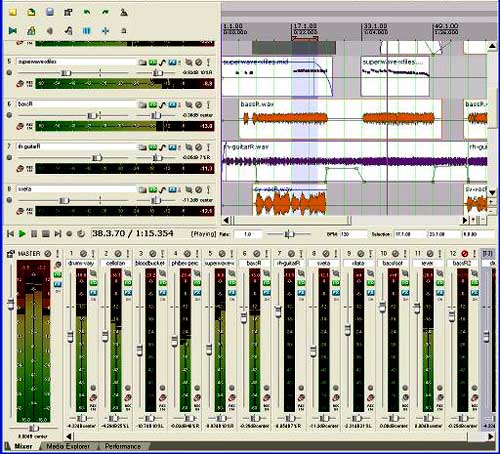Advertisement
Blog Archive
- ► 2021 (1)
- ► 2019 (3)
- ► 2017 (1)
- ► 2016 (7)
- ► 2015 (5)
- ► 2014 (26)
- ▼ 2013 (40)
- ► 2012 (34)
What is a DAW
What is a DAW

There are many different audio programs (softwares), but if you want to make music seriously than you will need to use one of the DAW's.
DAV is - Digital Audio Workstation. This means: the digital audio processing station. DAW, the term usually refers to two things.
First - It is a program that combines a MIDI-sequencer and multitrack recording and agent information. In the picture you see DAW Reaper during the work on the song. Note that the geometry of its operating windows are usually wider and taller. On the timeline are located recorded live guitars and vocals, as well as prescribed in the MIDI drums and keyboards, played through plugins synthesizers connected to the DAW.
DAW - this is your virtual incarnation of a home recording studio. In the DAW is the software mixer in which you mix together multiple parties. There are software effects - EQ, compressor, distortion, reverb, and more... There is also virtual instruments (VSTi). In the DAW you are recording live instruments, MIDI (from synthesizers to organs, guitars and flutes), prescribe party notes (or play with a real MIDI keyboard, or even normal), corrects the problem, and all you need. This is your main program (software) as a musician and sound engineer.
Another meaning DAW - a software and hardware system. I mean the combination of DAW software with some hardware - for example, feature-rich multi-channel sound card. An example of such a DAW - Pro Tools HD and Pro Tools LE.
Usually DAW, even pure software - very expensive. I will now review a little different DAW, and similar programs that you have an idea if it still does not have. Finally, I will focus on the Reaper, because it is based on it the examples in this article. Reaper is freely available to everyone and has all the features inherent dorogushchim commercial DAWs. In this review, I lose sight of DAWs for MAC OS - Logic and Digital Performer. Also will not consider Ableton Live, Reason, Arturia Storm, Orion Platinum.
Cool Edit Pro - a program like this old guitar players and some rappers. Cool Edit Pro is now bought by Adobe and is released under the name of Adobe Audition, but the original Cool Edit Pro (hereinafter CEP) is still in vogue. CEP is more than modest in the demands on system resources. CEP can operate in two modes - as usual wave gear and multi-track DAW. MIDI support is missing. Easy multitrack mode interface - that's what attracts people to it who are too lazy to learn the more complex (and giving more opportunities) program. However, CEP - one of the best DAW for very old computers. Suitable groups, record live. There is a free program that is somewhat similar to CEP - Audacity. Also does not require special resources. Write down the party on the tracks, and then judge them. However, Audacity can not hang on track real-time effects. That is all to apply the effect to a track, you can, but just to keep the track on the "non-destructive" process, as do other DAW, you can not.
FL Studio - it's just an old memory is still the name, the people they call Fruity Loops. There are several versions of this program, from the simple to the relatively tricked. FL Studio is loved mostly DJs and creators of electronic music. For example, in FL good at drum&bass. FL often misused. FL has a built-in drum machine, a set of virtual synthesizers and plugin support. In FL beautiful interface, and easy to create music newbie can start in a few seconds after his first run. But the difficulty of working with FL increases with the complexity of your work. In FL there is nothing that you can not do, for example, in Reaper, but there are things that simply can not be done technically in FL. FL, in spite of its function in the DAW-XXL-version is closer to the developed software synthesizers like Reason, but not to the "adult" DAW. That is, if we consider the FL as a DAW, then I can not say that FL was good as a DAW. But as a synthesizer FL good.
Cakewalk SONAR - One of the flagships of DAWs for Windows. Huge - it takes almost a full distribution DVD. t has a sound engine, where the calculations are performed with 64-bit resolution. As far as I know, so far there are only three of the engine - at Sonar, Reaper and Music Studio Independence. As well as any DAW, SONAR is composed of a set of virtual instruments and effects (depending on the version of the product). More than anything sensible about SONAR will not say - I do not use it for a long time, looked at a couple of years ago on the sixth version, and now the eighth came out.
Cubase - Cubase - is also one of the "flagships". The program operates a virtual studio concept (VST - Virtual Studio Technology). There are all sorts of scissors to cut the fragments of sound, a tube of glue to join them. In Cubase well-developed musical editor (in addition to pianorollu). Although the layout of score is usually used Sibelius, but those composers who prefer to write notes of the usual party, not through pianoroll will be very happy with Cubase. In general, and SONAR, Cubase and equipped with lots of features for working with MIDI. As for me, Cubase harder to master than the SONAR.
Nuendo - brother of Cubase. They have a common engine. Nuendo was sharpened by more work on the sound for movies, and Cubase to making music. But for some time in Nuendo is a division of functions was too clear - so, Nuendo has lost some of its MIDI-functions (now migrated to a separate plugin). Nuendo is good for recording live instruments, the voice acting, but it is more convenient to write music in Cubase.
Acid Pro - Originally it was a so-called "loop" sequencer, where music was going out of loops, which could change the pitch (ie, raise or lower the pitch sample). Acid gradually grown a MIDI-functions and became a full-fledged DAW. Standing attention version ACID - Music Studio and Pro. Some musical figures Acid confused with another program from Sony - Vegas. In fact, they look like they just Vegas - is a means of non-linear editing software, like Premiere Pro or Avid.
Samplitude/Sequoia - The relationship between the two DAW is about the same as that between Cubase and Nuendo, Sequoia that is more designed to work on the voice acting films. Samplitude - a powerful DAW. Previously, it was poorly implemented MIDI-functions, but now there is this complete order (including staves). But for audio processing Samplitude offers such things in other DAW do not often see - for example, you can hang the effects are not just on the track, but on a separate piece of sound! In general, work with audio in Samplitude something like working in vector graphics editors. Excellent program.
SAW Studio - Another exotic DAW, quite familiar with the interface and poor support for MIDI. Meet the SAW live even harder than Samplitude. SAW Studio has its own user base - people are used to program and use. Separate product to the SAW goes Midi WorkShop - MIDI-editor, built-in tools for working with MIDI in SAW Studio no. More than anything good or bad about SAW will not say.
Pro Tools - Is DAWs, which only work with sound equipment from Digidesign and M-Audio. Previously, under the name of Pro Tools only sold hardware and software DAW. Now add to this the Pro Tools M-Powered - version of Pro Tools, which works with sound cards from M-Audio. Some people believe Pro Tools the de facto standard in the world of DAW, and then what it's nowhere to go. As for me, many of the technologies have long taken for granted in other DAWs, has not translated into Pro Tools. For example, the Reaper, to play a game of virtual instrument, you simply create a track and connect it to the instrument. In Pro Tools you need in Cubase SX to version 4, to create two tracks, one for MIDI, one for audio, connect the instrument to the latter. A MIDI-tracks connected to this audio track. Pro Tools is limited to the number of effects simultaneously connected to the track. All audio files used in the project are copied to the project folder to the desired frequency re-capture project. When you import the video (to sync with audio) using Quick Time - and if Quick Time does not understand any format, any video project, you will not. In addition, Pro Tools plug-ins work only with its format - RTAS, so that your collection of plug-ins VST and DirectX does not find the application (if you do not want to fool their brains in search of the program adapter, occurring between one format and others). I note, however, that the large and expensive plug-ins - and the effects and instruments - often include and RTAS-version. But to free plug-ins are not affected. In my opinion, Pro Tools is good in conjunction with its "native" hardware from Digidesign.
Rosegarden - good at working with MIDI and layout notes. Working with audio tracks at the primary level. Support for virtual synthesizers in format DSSI.
MUSE - like Cubase versions to the line SX. Working with WAV better than Rosegarden, but the interface is rawer. Ardour - a very convenient and mature product, which stands at SAW and Nuendo, but so far without the full support of MIDI (but this is in development). In Ardour can be fully recorded and keep a "live" band - I did it myself.
-
Tags:
- daw
- digital audio workstation










